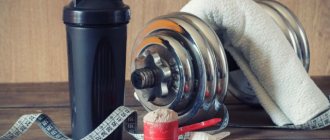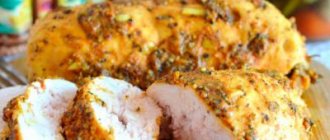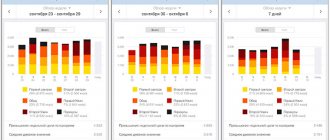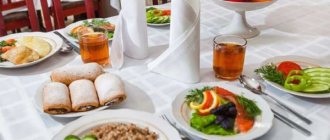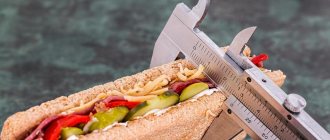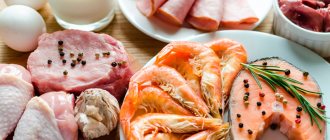Maintaining a balanced diet is not a diet, but a rule of life, that is, you should always eat right, and not just a couple of weeks a year. The consequences of an unhealthy diet are obvious:
- diseases of the cardiovascular system;
- hormonal imbalances;
- diseases of the gastrointestinal tract, kidneys and liver.
An incorrect diet is especially harmful for children, jeopardizing their future health. Therefore, not one person, but the whole family must switch to proper nutrition.
What is a balanced diet
A balanced diet is a nutritional system that provides the body with the “building” substances, vitamins and minerals necessary to maintain the functionality of cells, tissues, individual organs and the entire system that is the human body.
Content:
- What is a balanced diet
- Molecular basis of a balanced diet
- How to make your diet balanced: basic rules
- Components of a Balanced Diet
- What's prohibited
- Everyone has their own balance
- Balanced diet for weight loss
Failure to maintain a balanced diet can lead to various health problems: from chronic fatigue and lack of energy to dysfunction of vital organs. This type of diet does not belong to nutritional systems designed specifically for weight loss, but by following it, you can be sure that the body will not accumulate extra pounds of fat. A properly formulated balanced diet should contain all major food groups in optimal proportions. Compliance with the recommended caloric intake will help you avoid excess weight. But the correct calorie content is not the only requirement for a balanced diet. It is important to ensure that the body receives the proteins, fats, carbohydrates, micro- and macroelements, vitamins, fiber and other beneficial substances it needs every day. Most nutritionists in the world agree that one of the most balanced is the classic Mediterranean diet. If you take it as a basis, it’s easy to create a balanced menu for a week or even a month.
Molecular basis of a balanced diet
No diet can be called balanced if it does not contain enough carbohydrates, fats, proteins, fiber, vitamins or minerals. Let's briefly remember why the body needs these substances.
Carbohydrates. It is very difficult to achieve a zero carbohydrate content in the diet, but if this happens, then you can be sure that such nutrition will do more harm than good to the body (even with severe obesity). Carbohydrates serve as the main source of energy. In addition, they are necessary to maintain muscle shape (with a deficiency of carbohydrates, building protein from the muscles is consumed), these same substances serve as “food” for beneficial bacteria living in the intestines. Nutritionists advise composing your diet so that it consists of 45% carbohydrates (ideally, these should be slow carbohydrates).
Fats. Our body needs fats of plant and animal origin. They serve as an energy source, are indispensable for the proper functioning of the brain and nervous system, are important for maintaining the health of the skin and other tissues, are a component of cell membranes and an organic basis for the synthesis of steroid hormones. Fatty foods serve as a source of essential fatty acids (from the omega group), and are also indispensable for the proper absorption of fat-soluble vitamins A, , and.
Squirrels. The human body is, in fact, a collection of different proteins (our body contains from 30,000 to 50,000 types of protein compounds). Protein food is a source of essential amino acids, it is necessary for the formation of DNA, enzymes, hormones and special proteins in the body responsible for the transport of oxygen in the blood and the growth of muscle tissue, it is necessary for the normal condition of bones, hair, and nails. Without exaggeration, every cell in the human body needs proteins. The source of this nutrient should be natural food, since the bioactivity of protein food supplements is much worse. Although protein abuse is just as dangerous for humans as protein deficiency.
Cellulose. Another name for this substance is dietary fiber. This is a special type of carbohydrate that is not absorbed by the body. The indispensability of fiber is that it is responsible for the normal functioning of the intestines and maintains healthy microflora in it, improves digestion, removes toxins from the body and reduces the risk of developing cancer. But when taking large amounts of fiber, it is important to ensure that you drink enough fluids, otherwise there is a risk of constipation.
Vitamins. You can talk about the benefits of these substances for a very long time, and about each separately. In short, each of them performs its own function, which is collectively manifested by the correct growth, development and smooth functioning of the entire system of the human body. As a rule, a lack of any of the vitamins triggers a domino effect, and as a result, the entire body suffers.
Minerals. Our bodies cannot produce minerals on their own, so it is important to replenish their reserves from food. Each mineral, like vitamins, plays a specific role in the body. Maintaining mineral balance is the key to the balanced functioning of all organs and systems, including healthy bones, teeth, skin and hair, blood composition and healthy metabolism.
“Marble” chicken fillet roll
In addition to 900g chicken fillet, the recipe uses:
- 30 g gelatin;
- 4 garlic cloves;
- spices: salt, black pepper, paprika.
Finely chopped garlic, gelatin, and all the spices are added to the fillet, cut into pieces weighing 25-30 g. All the products are mixed and filled into a baking sleeve, forming a roll from it, and then the fillet is left to marinate in the baking dish for an hour.
"Marble" roll
Before baking, the sleeve is pierced in several places with a needle so that it does not burst due to high temperature (up to +180 degrees). The meat is baked in the oven for an hour. At the end, the slightly cooled roll is wrapped in cling film, allowed to cool to room temperature, and then placed in the refrigerator to harden for 4-5 hours.
How to make your diet balanced: basic rules
For a truly balanced nutritional system, it is important to pay attention not only to what we eat, but also how often. According to most experts, proper nutrition should consist of 5-6 meals, although some nutritionists (mainly in the West) defend the right to 3 meals a day. But both the former and the latter agree that perhaps the main meal of the day is breakfast, so it should absolutely not be skipped. Each meal should contain foods from different food categories (during the day you should eat food from all permitted groups), and portion sizes should be moderate and correspond to the required calorie content. By the way, there are several opinions regarding calorie content. The most popular version recommends that a man’s daily diet should be 2320 kcal, while women need only consume 1900 kcal per day.
Alcohol in a balanced diet is, if not completely prohibited, then strict restrictions are imposed on its use. In addition to alcohol, you should also control portions of sugar and salt, and also limit the consumption of foods rich in saturated lipids and trans fats, and be careful about cholesterol foods.
In addition, a diet cannot be called balanced if the daily diet includes less than 2 liters of clean still water and there is no room for moderate physical activity. Water and sports are the two “building blocks” without which it is impossible to achieve balance in the body.
Daily regimen for weight loss
A properly designed weight loss regimen suits your individual characteristics. When forming it, you don’t need to blindly follow templates, but you should listen to yourself. Otherwise, you risk harm to your health. Start by analyzing your lifestyle: how much you sleep, what time you go to bed and get up, what intervals between rest and work take place. Once you have decided, create a schedule that includes the following parameters:
- Set a specific bedtime and wake-up time. It should be the same every day, excluding weekends. Systematization helps to utilize the body's resources and helps speed up weight loss.
- Every morning you need to spend about 15 minutes. for charging. Simple physical exercises will add tone, vigor, and create a good mood.
- Breakfast is a must, never skip it. Morning nutrition helps improve the functioning of the digestive system. Give preference to water- or milk-based cereals, yogurt, fruits and fresh juices. You will need to eat at the same time every day.
- Develop a meal plan for the whole day. The correct regimen includes 5 meals, of which 3 main meals and 2 snacks. The difference between them should be from 2 to 3 hours.
- Physical activity, in addition to exercise, helps restore strength after a working day. You can go to the gym, pool, dance or exercise at home.
Eating by the clock for weight loss
To properly plan your meals over time for weight loss, try to follow some conditions:
- The first meal (breakfast) must be taken between 7 and 9 o'clock. At the same time, remember that you should start eating at least half an hour after waking up. Include in your menu foods with a large amount of complex carbohydrates (durum pasta, buckwheat, bran). Add protein component. Kefir and yogurt are suitable for this purpose.
- The second part of your daily diet when losing weight should be a second breakfast. It is important for the proper functioning of the body. Prepare a vegetable or fruit salad, juice or low-calorie dessert. This snack should begin 3 hours after the main meal.
- The best time for lunch is between noon and 2 p.m. Even when losing weight, it should be dense, contain fats, carbohydrates and proteins.
- At 15-16 hours, have an afternoon snack of kefir, yogurt or cottage cheese. You can drink some diet broth.
- When losing weight, dinner is scheduled between 17:00 and 19:00. Prepare any dietary grade of meat and vegetables.
Drinking regime for weight loss
You can organize a correct drinking regime when losing weight using the following recommendations:
- Avoid caffeine, alcohol and cigarettes as they contain substances that cause dehydration.
- For better absorption of the liquid, drink it slightly chilled.
- The richer the food is in protein, the more water you will need to drink.
- It is better to drink liquid an hour before and after meals. This regimen helps dilute gastric juice.
- A glass of water drunk in the morning after getting up helps cleanse the body.
- Normally, a person needs to drink 8 glasses of clean water per day.
Components of a Balanced Diet
Dairy
Different types of cheese, milk, sour cream, kefir, yogurt and other dairy products are indispensable in the diet as a source of calcium, protein and vitamin D. People with lactose intolerance should focus on fermented milk products, and replace cow's milk with nut or soy milk, or take calcium in as a dietary supplement.
Protein food
This group includes lean meats, poultry, fish, beans, nuts, seeds, eggs, and soy products. It is important that in addition to protein, foods in this category contain many other beneficial substances. For example, meat contains a lot of iron, beans contain fiber, eggs contain an impressive complex of vitamins and minerals, and sea fish, in addition to protein, is rich in omega-3 fatty acids. To prepare any of these products, it is important to choose methods that require the addition of a minimum amount of fat. It would also be better to avoid processed foods and sausages, as they are usually oversaturated with fats and sodium. When compiling a menu for the day, it is important to take into account the fact that approximately 30-35% of the total calorie content should be protein foods. This means that a man should eat about 60 g of protein daily, and a woman should eat about 55 g.
Fruits
Fruits contain no fat, most are low in calories, but are very nutritious. By including different types of fruits in your diet, you can get plenty of fiber as well as most vitamins and minerals. People who prefer fruit juices and dried fruits should remember that fruit products in this form contain much more calories, so it is advisable to control portions.
Vegetables
As a rule, this is the lowest calorie food group. But nevertheless, vegetables are an excellent source of vitamins, minerals and fiber, and therefore are considered essential for humans. A balanced diet involves eating a variety of vegetables, cooked with minimal fat. You should also be careful with starchy vegetables. They are advised to consume no more than 100 g per day.
Cereals
This food group is necessary as a source of so-called slow (correct) carbohydrates. Nutritionists advise regularly consuming whole grains, as they contain more fiber, as well as the maximum amount of B vitamins. Different types of cereals, whole grain bread and some durum wheat pasta are what, according to experts, will benefit the human body. body. But it is useful to avoid cereals, sweet baked goods and crackers with sweeteners or other flavoring additives. Nutritionists advise consuming at least 30 g of cereals every day.
Fats and oils
In fact, fat is not something dangerous for the body; on the contrary, fatty acids are essential for maintaining the functionality of most organs. Fat becomes dangerous only when it is in excess or in the wrong form (the same trans fats). But small portions of butter, olive or other types of vegetable oils should be present in the diet. Fatty foods should account for 1/5 of the daily calorie intake. By the way, do not forget that the source of healthy fats is not only different types of oil, but also nuts, seeds, sea fish, avocados, and olives.
Menu for the week: personal experience
In the short term, it's difficult to know how home-cooked lunches will affect health and weight compared to business lunches. But you can check how this will affect your wallet, which is what I did.
To provide myself with lunches for the whole week, I bought:
- 3 chicken breast fillets (bought by weight);
- 1 long-fruited cucumber;
- 1 head of cabbage;
- 200 g champignons;
- 1 jar of sour cream;
- 1 pack of funchose.
I had the rest of the products at home, otherwise I would have had to buy additional:
- rice;
- sunflower oil;
- rice vinegar;
- soy sauce;
- eggs;
- flour;
- salt and spices.
Theoretically, if your goal is to dine on a budget, you can get by with a smaller set.
My menu is based on two dishes: grilled chicken and cabbage fried with mushrooms. You can cook them at the same time on Sunday or postpone frying the cabbage until Monday. So on Monday I cook all the chicken and on Tuesday I cook all the cabbage.
Monday: grilled chicken and salad
Ingredients:
- 3 chicken breast fillets;
- 1 tablespoon soy sauce;
- 200 g cabbage;
- ½ cucumber;
- 1 tablespoon of sour cream.
Preparation
Cut the chicken fillet into long thin strips and marinate in soy sauce (can be mixed with water). If you have time, leave the meat to soak for a while and then sear. I use an electric grill, but a regular frying pan will work. This meat will be one of the bases for the week's menu.
To pack lunch for Monday, set aside almost half of the cooked chicken in a container. The second container will contain salad. For it, chop the cabbage, cut the cucumber, mix, season with sour cream.
Save the rest of the grilled chicken for Wednesday and Friday.
Tuesday: cabbage fried with mushrooms
Ingredients:
- 500 g cabbage;
- 150 g mushrooms;
- 1 teaspoon sunflower oil.
Preparation
Chop the mushrooms, chop the cabbage, fry in oil. This dish can easily be transformed into a stew - just cover the pan with a lid while doing so.
To assemble lunch for Tuesday, place ⅔ of the cooked cabbage in a container. A piece of bread will not be superfluous, since the dish will not be very high in calories.
The leftover cabbage will come in handy on Thursday.
Wednesday: Chicken with rice and mushroom sauce
Ingredients:
- ½ remaining chicken;
- 50 g dry rice;
- 50 g mushrooms;
- 1 heaped tablespoon of sour cream.
Preparation
Cut the chicken into small pieces. Boil the rice. Chop the mushrooms and fry (you can add sunflower oil), when they turn golden, add sour cream and heat.
Place rice and chicken in a container, pour mushroom sauce over it all.
Thursday: jellied pie
Ingredients:
- leftover fried cabbage;
- 1 egg;
- 2 tablespoons sour cream;
- 50 g flour.
Preparation
Mix egg, sour cream and flour. Place cabbage in a silicone mold and fill it with flour mixture. You may need to spread the cabbage with a fork to ensure the filling is evenly distributed throughout the pie.
Bake at 200°C for about 30 minutes.
Friday: chicken with funchose
Ingredients:
- leftover chicken;
- 40 g dry funchose;
- ¼ cucumber;
- rice vinegar to taste.
What's prohibited
Foods that do not fit into the above categories are considered unhealthy for humans and are not included in a balanced diet. Among the most popular foods that “unbalance” a healthy diet are candy, chocolate, cakes, chips and other fast food products. If you really want to, then on rare occasions you can treat yourself to dessert as a form of relaxation, but in this case it is better to give preference to an option containing less than 145 kcal.
Low-calorie salad “Mazurka”
This salad is not only low-calorie, but also lean, so its presence is quite appropriate on the festive table during the period of Orthodox Lent. The following ingredients are used in the salad:
- 300 g each of canned corn and red beans;
- two sweet peppers;
- two pickled cucumbers;
- 100 g walnut kernels;
- 2 cloves of garlic.
Salad "Mazurka"
Peppers and cucumbers are cut into cubes and added to the beans and corn. The garlic and nuts are crushed and added to the vegetables, and a finely chopped bunch of parsley is added. The salad is salted and seasoned with 4 tablespoons of olive oil.
Everyone has their own balance
This diet is not a nutrition plan with a clear definition of the amount of food. A balanced menu for everyone is unique, their own. What different organisms need depends on different factors:
- age;
- gender;
- lifestyle;
- health conditions;
- physical activity.
In addition, vegetarians, meat lovers, pregnant women and athletes have their own balanced nutrition options. There are also variations of the diet to support healthy weight and for obese people.
Standard option. This is the skeleton around which you can create different diet options while maintaining the key principles.
Breakfast of any balanced diet consists of carbohydrates (cereals), 1 fruit and protein. A snack is always a fruit or vegetable (can be in the form of juice or salad). A balanced lunch should contain proteins, vegetables and complex carbohydrates (for example, a slice of whole grain bread or cereal). The second snack in this food system is dairy products and a vegetable or fruit. For dinner, it is good to eat fish or meat (alternate), beans, complex carbohydrates and vegetables.
Meat free option. For breakfast, you can prepare an omelet from 2 eggs (in olive oil) and drink green tea. For a snack, fruit salad is suitable, and for lunch - bean soup and cabbage salad. For a second snack, choose nuts or dried fruits, and for dinner, risotto and fresh tomatoes are suitable.
An option for maintaining a stable weight. Weight-conscious people can have breakfast without remorse with their favorite porridge with 2 egg whites, after which they can eat another grapefruit and drink tea or coffee. It is healthy to have cottage cheese as a snack, and to have fish and stewed vegetables for lunch. For a second snack, it is useful to eat yogurt and an apple. If you don’t want dinner to leave fat on your sides, then your option is stewed cabbage with chicken breast and a glass of herbal tea.
Option for obesity. There are special medical diets to treat obesity, but a balanced diet can also help you lose weight. It is useful for obese people to have breakfast with low-fat cottage cheese and carrot salad. For snacks during the day, you can take fruits, berries or cottage cheese. For lunch it is useful to eat vegetarian borscht, 100 g of lean meat and some stewed vegetables. A good option for dinner is steamed fish and vegetables.
Option for athletes. Breakfast for active people can consist of oatmeal, boiled eggs and milk. You can have lunch with potatoes, your favorite type of meat and salad, and for dinner, for example, fish and a salad of boiled beans. For a snack, choose fruit or vegetable juices.
Option for pregnant women. Pregnancy is a special period when the female body requires a specific diet. The following menu can serve as an example. Breakfast is milk porridge, a snack is yogurt, lunch is pea soup, fish and stewed vegetables, a second snack is fruit salad, and for dinner unsalted cheese and vinaigrette.
Making a grocery list
When compiling a list of products for a complete menu for a family for a week, you should take into account the tastes of each family member, your financial capabilities, and the seasonality of some fruits. Considering the principles of healthy eating, your list should include the following healthy foods:
- eggs;
- bird;
- meat;
- dairy, fermented milk products;
- seafood, fish;
- cereals;
- greens, vegetables;
- spices;
- berries and fruits;
- vegetable oils;
- apple marmalade, marshmallows or dried fruits if you want something sweet;
- whole grain or yeast-free rye bread.
